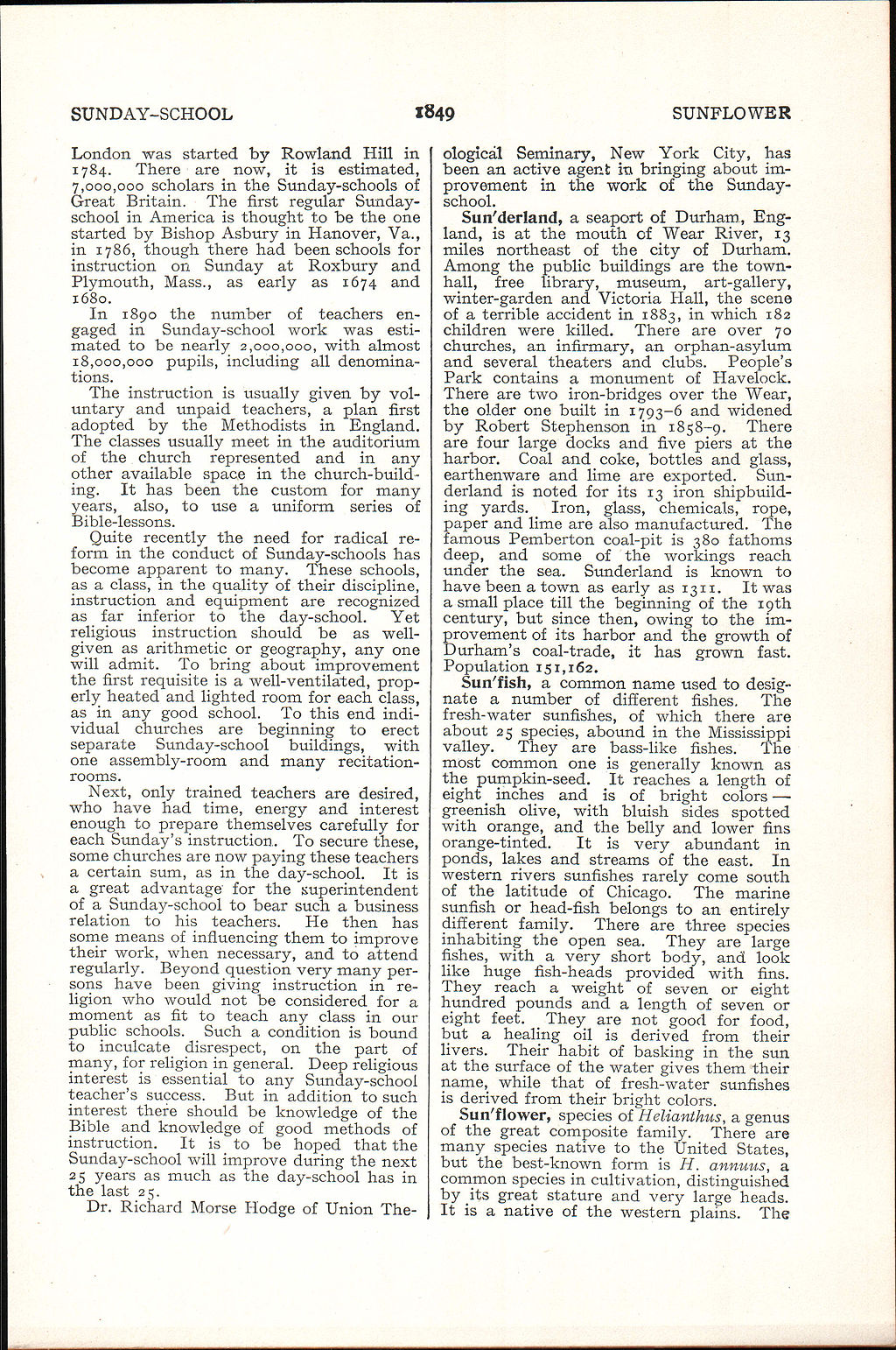London was started by Rowland Hill in 1784. There are now, it is estimated, 7,000,000 scholars in the Sunday-schools of Great Britain, The first regular Sunday-school in America is thought to be the one started by Bishop Asbury in Hanover, Va., in 1786, though there had been schools for instruction on Sunday at Roxbury and Plymouth, Mass., as early as 1674 and 1680.
In 1890 the number of teachers engaged in Sunday-school work was estimated to be nearly 2,000,000, with almost 18,000,000 pupils, including all denominations.
The instruction is usually given by voluntary and unpaid teachers, a plan first adopted by the Methodists in England. The classes usually meet in the auditorium of the church represented and in any other available space in the church-building. It has been the custom for many years, also, to use a uniform series of Bible-lessons.
Quite recently the need for radical reform in the conduct of Sunday-schools has become apparent to many. These schools, as a class, in the quality of their discipline, instruction and equipment are recognized as far inferior to the day-school. Yet religious instruction should be as well-given as arithmetic or geography, any one will admit. To bring about improvement the first requisite is a well-ventilated, properly heated and lighted room for each class, as in any good school. To this end individual churches are beginning to erect separate Sunday-school buildings, with one assembly-room and many recitation-rooms.
Next, only trained teachers are desired, who have had time, energy and interest enough to prepare themselves carefully for each Sunday's instruction. To secure these, some churches are now paying these teachers a certain sum, as in the day-school. It is a great advantage for the superintendent of a Sunday-school to bear such a business relation to his teachers. He then has some means of influencing them to improve their work, when necessary, and to attend regularly. Beyond question very many persons have been giving instruction in religion who would not be considered for a moment as fit to teach any class in our public schools. Such a condition is bound to inculcate disrespect, on the part of many, for religion in general. Deep religious interest is essential to any Sunday-school teacher's success. But in addition to such interest there should be knowledge of the Bible and knowledge of good methods of instruction. It is to be hoped that the Sunday-school will improve during the next 25 years as much as the day-school has in the last 25.
Dr. Richard Morse Hodge of Union Theological Seminary, New York City, has been an active agent m bringing about improvement in the work of the Sunday-school.
Sun′derland, a seaport of Durham, England, is at the mouth of Wear River, 13 miles northeast of the city of Durham. Among the public buildings are the town-hall, free library, museum, art-gallery, winter-garden and Victoria Hall, the scene of a terrible accident in 1883, in which 182 children were killed. There are over 70 churches, an infirmary, an orphan-asylum and several theaters and clubs. People's Park contains a monument of Havelock. There are two iron-bridges over the Wear, the older one built in 1793-6 and widened by Robert Stephenson in 1858-9. There are four large docks and five piers at the harbor. Coal and coke, bottles and glass, earthenware and lime are exported. Sunderland is noted for its 13 iron shipbuilding yards. Iron, glass, chemicals, rope, paper and lime are also manufactured. The famous Pemberton coal-pit is 380 fathoms deep, and some of the workings reach under the sea. Sunderland is known to have been a town as early as 1311. It was a small place till the beginning of the 19th century, but since then, owing to the improvement of its harbor and the growth of Durham's coal-trade, it has grown fast. Population 151,162.
Sun′fish, a common name used to designate a number of different fishes. The fresh-water sunfishes, of which there are about 25 species, abound in the Mississippi valley. They are bass-like fishes. The most common one is generally known as the pumpkin-seed. It reaches a length of eight inches and is of bright colors—greenish olive, with bluish sides spotted with orange, and the belly and lower fins orange-tinted. It is very abundant in ponds, lakes and streams of the east. In western rivers sunfishes rarely come south of the latitude of Chicago. The marine sunfish or head-fish belongs to an entirely different family. There are three species inhabiting the open sea. They are large fishes, with a very short body, and look like huge fish-heads provided with fins. They reach a weight of seven or eight hundred pounds and a length of seven or eight feet. They are not good for food, but a healing oil is derived from their livers. Their habit of basking in the sun at the surface of the water gives them their name, while that of fresh-water sunfishes is derived from their bright colors.
Sun′flower, species of Helianthus, a genus of the great composite family. There are many species native to the United States, but the best-known form is H. annuus, a common species in cultivation, distinguished by its great stature and very large heads. It is a native of the western plains. The
